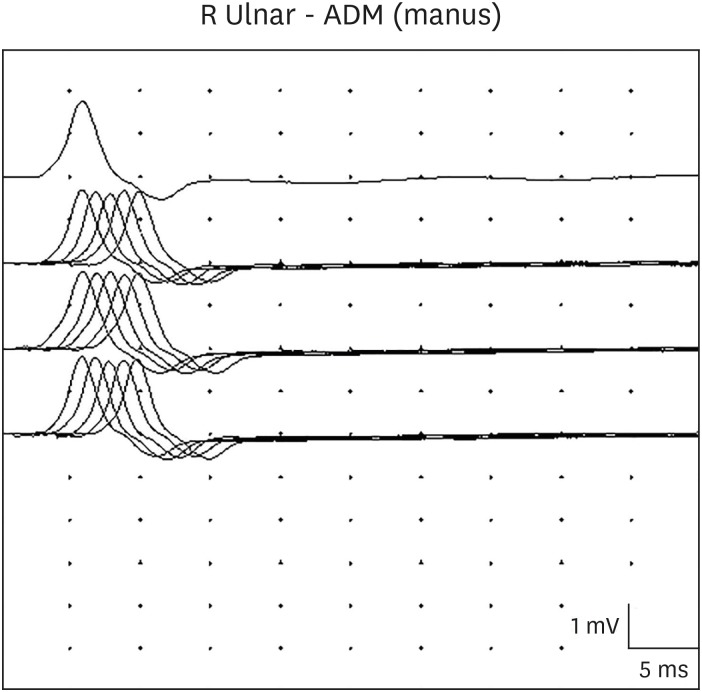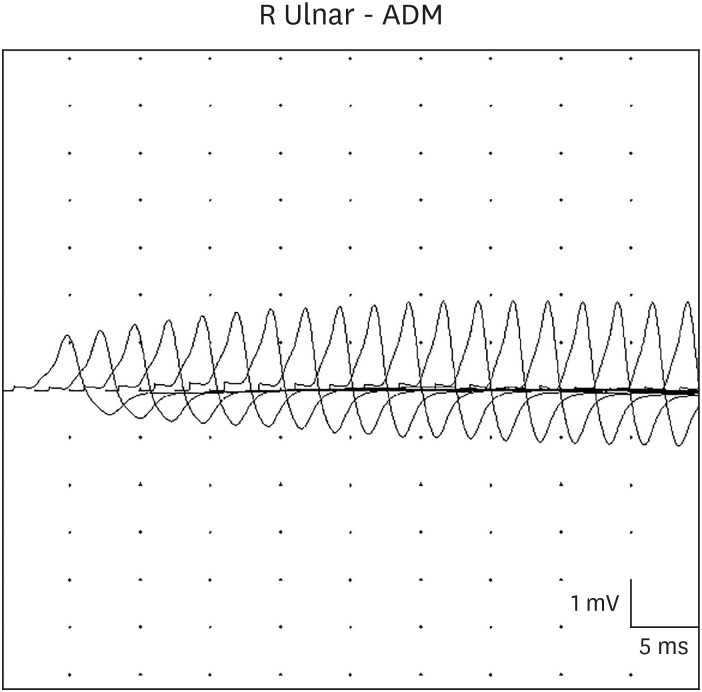J Korean Med Sci.
2020 Apr;35(14):e93. 10.3346/jkms.2020.35.e93.
The First Reported Case of Infant Botulism in Korea: Treatable Infantile Neuromuscular Disease
- Affiliations
-
- 1Department of Pediatrics, Ajou University Hospital, Ajou University School of Medicine, Suwon, Korea.
- KMID: 2509618
- DOI: http://doi.org/10.3346/jkms.2020.35.e93
Abstract
- Botulism is a rare neuromuscular disorder caused by neurotoxins produced by Clostridium botulinum. The diagnosis of infant botulism may be obscured or delayed, as its presentation is similar to that of infantile neuromuscular disorders. We report the first Korean case of infant botulism in an acute progressive floppy infant with poor sucking and a weak cry. No abnormalities were found in all blood, cerebrospinal fluid, genetic test, nerve conduction study, and imaging studies. A stool-toxin test was finally performed under suspicion of infant botulism, and the result was positive. The patient was immediately treated with heptavalent botulism antitoxin. Follow-up after 3 months showed normal development with a complete resolution of all symptoms. Therefore, clinical suspicion of infant botulism, which is a treatable infantile neuromuscular disease, is essential for early diagnosis and prompt treatment in the differential diagnosis of a floppy infant.
Figure
Cited by 1 articles
-
Genetic Characterization of
Clostridium botulinum Isolated from the First Case of Infant Botulism in Korea
Jun Ho Jeon, Chi-Hwan Choi, Jeong Hyun Kim, Junghee Hyun, Eun-Sun Choi, Sang-Yoon Choi, Yong-Woo Shin, Seong Wook Pyo, Dae-Won Kim, Byung Hak Kang, Young Joon Park, Gi-eun Rhie
Ann Lab Med. 2021;41(5):489-492. doi: 10.3343/alm.2021.41.5.489.
Reference
-
1. Lund BM. Foodborne disease due to Bacillus and Clostridium species. Lancet. 1990; 336(8721):982–986. PMID: 1977014.
Article2. Cox N, Hinkle R. Infant botulism. Am Fam Physician. 2002; 65(7):1388–1392. PMID: 11996423.3. Schreiner MS, Field E, Ruddy R. Infant botulism: a review of 12 years' experience at the Children's Hospital of Philadelphia. Pediatrics. 1991; 87(2):159–165. PMID: 1898989.4. Koepke R, Sobel J, Arnon SS. Global occurrence of infant botulism, 1976–2006. Pediatrics. 2008; 122(1):e73–82. PMID: 18595978.
Article5. Kauiter DA, Lilly T Jr, Solomon HM, Lynt RK. Clostridium botulinum spores in infant foods: a survey. J Food Prot. 1982; 45(11):1028–1029. PMID: 30913614.6. Thompson JA, Glasgow LA, Warpinski JR, Olson C. Infant botulism: clinical spectrum and epidemiology. Pediatrics. 1980; 66(6):936–942. PMID: 7005856.7. Hauschild AH, Hilsheimer R, Weiss KF, Burke RB. Clostridium botulinum in honey, syrups and dry infant cereals. J Food Prot. 1988; 51(11):892–894. PMID: 30991497.8. Rosow LK, Strober JB. Infant botulism: review and clinical update. Pediatr Neurol. 2015; 52(5):487–492. PMID: 25882077.
Article9. Long SS, Gajewski JL, Brown LW, Gilligan PH. Clinical, laboratory, and environmental features of infant botulism in Southeastern Pennsylvania. Pediatrics. 1985; 75(5):935–941. PMID: 3887319.10. Murrell WG, Stewart BJ. Botulism in New South Wales, 1980–1981. Med J Aust. 1983; 1(1):13–17. PMID: 6400580.
Article11. Takahashi M, Shimizu T, Ooi K, Noda H, Nasu T, Sakaguchi G. Quantification of Clostridium botulinum type A toxin and organisms in the feces of a case of infant botulism and examination of other related specimens. Jpn J Med Sci Biol. 1988; 41(1):21–26. PMID: 3057266.12. Mitchell WG, Tseng-Ong L. Catastrophic presentation of infant botulism may obscure or delay diagnosis. Pediatrics. 2005; 116(3):e436–8. PMID: 16140690.
Article13. Nevas M, Lindström M, Virtanen A, Hielm S, Kuusi M, Arnon SS, et al. Infant botulism acquired from household dust presenting as sudden infant death syndrome. J Clin Microbiol. 2005; 43(1):511–513. PMID: 15635031.
Article14. Wigginton JM, Thill P. Infant botulism. A review of the literature. Clin Pediatr (Phila). 1993; 32(11):669–674. PMID: 8299297.15. Fenicia L, Anniballi F. Infant botulism. Ann Ist Super Sanita. 2009; 45(2):134–146. PMID: 19636165.16. Cherington M. Electrophysiologic methods as an aid in diagnosis of botulism: a review. Muscle Nerve. 1982; 5(9S):S28–9. PMID: 6763148.17. Rao AK, Lin NH, Griese SE, Chatham-Stephens K, Badell ML, Sobel J. Clinical criteria to trigger suspicion for botulism: an evidence-based tool to facilitate timely recognition of suspected cases during sporadic events and outbreaks. Clin Infect Dis. 2017; 66(suppl_1):S38–S42. PMID: 29293926.
Article



